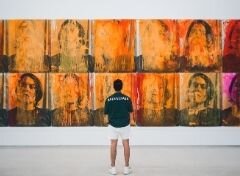How Charitable Donors Can Support the Arts
2020 has been no easy road to travel for any of us. Between the immediate needs of the COVID-19 crisis and the overdue focus on racial justice and inequity, it can be challenging to know how to help. Donors are asking: How can they be creative about deploying charitable capital at the intersection of the issue areas they care most about and the arts?
Arts nonprofits were among the first to shut down in the COVID-19 crisis and aren’t expected to re-open for some time, putting an enormous strain on the creative economy that relies on audiences attending arts events. Americans for the Arts estimates that nationally, financial losses to nonprofit arts and cultural organizations are an estimated $13.1 billion as of September 14, 2020. Arts nonprofits also lost 355 million admissions due to canceled events, resulting in an $11.2 billion loss in event-related spending by audiences at local businesses like restaurants and retail.1
In turn, this has a negative impact on the nation’s economy as a whole. In a 2017 report published by Americans for the Arts performing and visual arts organizations, including festivals, public art programs and municipally-owned museums, pumped an estimated $63.8 billion into the national economy. This leveraged an additional $102.5 billion in event-related spending by arts audiences.2
The effects of an arts shutdown go well beyond economics.
Smaller arts organizations that act as lifelines for a community, in areas such as educational support for youth or mental health interventions families and elders, have been displaced or closed. Similarly, large arts and cultural institutions cannot offer their services during this crisis, eliminating a crucial building-block of community connection and support. Jason Holland, vice president of community engagement for the Segerstrom Center for the Arts, points out that the elimination of these arts programs highlights how desperately communities truly need them.
“We remain limited in our thinking around arts organizations as only buildings,” Holland said. “This is the moment that arts organizations must focus deeply on the needs of under-resourced communities and communities of color who, right now, need more support than ever.”
I often recommend that donors seek arts organizations that align with the values already reflected in their philanthropy. Through the arts donors can support improved health outcomes for elders, affordable housing and community development, disability rights, cultural equity, trauma-informed interventions for youth in the juvenile justice system, criminal justice reform – the list goes on and on!
By funneling community engagement and addressing social issues through the arts, the outcomes can be deep and lasting. For example, conversations about racial injustice might be scary, painful or easy to avoid, but a photograph, play, song or poem can offer a safe place for expression and hearing– and maybe even a bridge to those tough conversations.
How do you decide where to give?
Seek arts organizations that align with the values already reflected in your philanthropy.
The arts intersect with virtually every issue area in philanthropy from education and youth development, to support for youths with autism, mental health interventions, women and girls, cultural preservation, economic development and everything in between. The arts are part of a holistic funding approach. Through the arts, donors can address root-cause issues, advocate for change or offer direct support.
Donors giving with an equity lens should consider prioritizing support for arts organizations led by BIPOC (Black, Indigenous, People of Color) and Queer leaders.
There is a disproportionate lack of arts organizations with non-white leaders. Donors may wish to prioritize funding to African, Latinx, Asian, Arab and Native American (ALAANA) and LGBTQIA+-led arts organizations in support of giving a voice to marginalized populations, and in speaking and hearing the languages we can all understand as humans, such as music, dance, and performance art.
Consider unrestricted funding.
Unrestricted funding allows nonprofits to keep the lights on during this crisis and beyond. Let the organizations you trust utilize your funding to support their greatest need as they pivot, even if that means paying salaries or rent.
As we look forward to a post-COVID life, our global community is facing astronomical challenges. In these times, donors can provide support for the arts consistent with their values and at a critical time for the sector.

